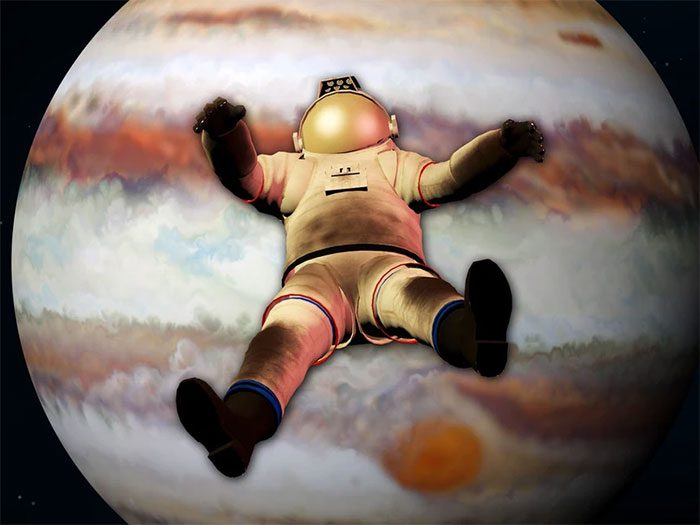Jupiter, the giant of the Solar System, has always fascinated humanity. Its colossal size and mysterious atmospheric conditions have inspired space explorers with a deep desire to investigate it.
Why Do Jupiter’s Unique Conditions Prevent Human Robots and Probes from Landing?
As one of the largest planets in the Solar System, Jupiter has numerous special conditions that make it impossible for human probes to land on its surface. The strong gravitational field of Jupiter is one of the primary reasons that human probes cannot land. Since Jupiter has a massive weight, its gravitational pull is also quite strong.
When human probes approach Jupiter, they are strongly attracted by its gravity, making it difficult to escape its gravitational pull. This prevents the probes from reaching Jupiter’s surface as they cannot overcome the colossal gravitational force. Even if a probe successfully enters a close orbit around Jupiter, it will face the issue of being pulled by gravity, causing oscillation and instability, making safe landing impossible.

Humanity has a long history of exploring Jupiter, but is there any other way to understand this mysterious planet? In addition to traditional detection methods, we can also observe and study Jupiter through unmanned probes, remote sensing technology, and simulation experiments.
Jupiter’s climatic conditions also complicate human landing attempts. The atmosphere of Jupiter is very thick, containing a large amount of hydrogen and helium. This poses a significant challenge for any probe attempting to land. Because Jupiter’s atmospheric density is very high, probes find it difficult to penetrate this gas layer as they face extreme pressure and temperature. Jupiter’s atmosphere is also rich in ammonia and clouds, which can severely damage the probe’s electronics and communication systems.
Jupiter’s strong magnetic field is another issue preventing probes from landing. Its magnetic field is one of the strongest in the Solar System, much stronger than Earth’s. This means that any probe entering Jupiter’s vicinity will experience significant magnetic interference. The magnetic disruption can adversely affect the probe’s electronic devices and navigation systems, causing them to malfunction.
The radiation belts of Jupiter are also critical factors that make it impossible for human probes to land. Jupiter’s radiation belts consist of ions and high-energy particles trapped by its strong magnetic field. These high-energy particles can cause severe damage to the probe’s electronics and solar panels. To land near Jupiter, a probe must contend with the radiation from these high-energy particles, but current technology cannot effectively handle this radiation.

Remote sensing technology is also one of the important means of detecting Jupiter. Using remote sensing satellites, scientists can conduct high-resolution observations of Jupiter’s surface features.
The unique conditions of Jupiter make it extremely difficult for human probes to land on its surface. Strong gravity, thick atmosphere, massive magnetic fields, and high-energy radiation are all insurmountable obstacles. While scientists are eager to explore the mysteries of Jupiter, current technological capabilities have yet to overcome these challenges. However, we can still utilize probes to observe Jupiter in its orbit to learn more about the mysteries of this enigmatic planet.
What Technical Difficulties Exist That Make Landing on Jupiter Extremely Challenging?
Jupiter is the largest planet in the Solar System and one of the potential targets for human exploration. However, landing on Jupiter poses significant technical challenges. The gravitational force of Jupiter is about 2.5 times that of Earth, which means that during the landing process, the immense gravitational pull will exert a substantial physical impact on the lander. To successfully land on Jupiter, the following issues must be addressed:
Thermal Issues: Landing on Jupiter at low altitudes would lead to significant frictional heat, which could destroy the structure and materials of the lander. Scientists need to design materials that can withstand extreme pressure and high temperatures to ensure the integrity of the lander.

Simulation experiments can also be used to understand Jupiter’s properties. These experiments aim to combine environmental and laboratory conditions with target objects while studying and observing the characteristics of Jupiter through real physical experiments.
Landing Module Design: To successfully counteract the extreme gravitational forces, the lander needs a powerful propulsion system while ensuring sufficient fuel reserves. Designing an advanced landing system capable of withstanding severe gravity and friction is a significant challenge.
Jupiter has extreme environmental conditions, including high radiation, strong winds, and extremely low temperatures. These conditions present serious challenges for lander design.
Firstly, Jupiter’s radiation is very intense, so figuring out how to design an effective radiation protection system to safeguard the instruments and equipment inside the lander is a crucial technical issue. Jupiter’s atmosphere is very dense, and wind speeds can exceed 200 meters per second. The strong winds and storms not only threaten the stability of the lander but can also damage the parachute and deceleration systems.
The average temperature on Jupiter can reach minus 160 degrees Celsius. In such a harsh environment, ensuring stable internal temperatures within the lander and maintaining normal equipment operation is also a significant consideration.

Landing on Jupiter is an extremely challenging task. (Illustrative image).
To address the technical difficulties of landing on Jupiter, scientists can implement the following measures:
- Develop advanced materials suitable for the extreme temperature and pressure environment to ensure the integrity and performance of the lander. Developing an efficient power system to meet the energy needs of the lander in Jupiter’s environment, allowing it to operate normally while withstanding extreme pressure and high temperatures.
- Enhance the lander’s autonomy to quickly respond and adapt to Jupiter’s environment to ensure smooth mission execution. To improve the success rate of the probe, a multiple-detection strategy can be applied to support and complement each other through the cooperative operation of multiple landers.
Landing on Jupiter is an incredibly challenging task that faces significant technical difficulties. However, with the continuous advancement and innovation of science and technology, we can believe that humanity has the potential to overcome these technical issues. Through collaboration and multifaceted efforts, humanity will achieve the dream of stepping foot on Jupiter in the future and gather more scientific knowledge and resources about this planet.





















































